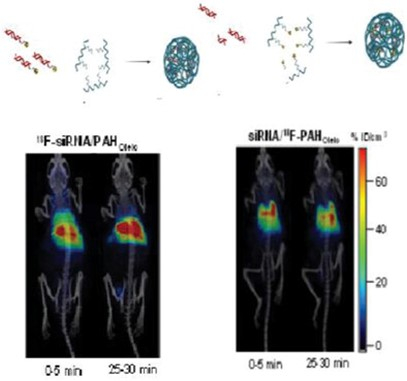Polyamine-based vectors offer many advantages for gene therapy, but they are hampered by a limited knowledge on their biological fate and efficacy for nucleic acid delivery. The 18F radiolabeled siRNA is complexed with poly(allyl amine) hydrochloride (PAH), PEGylated PAH (PAHPEG), or oleic acid-modified PAH (PAHOleic) to form polyplexes, and injected them intravenously into healthy rodents. The biodistribution patterns obtained by positron emission tomography (PET) imaging vary according to the polymer used for complexation. Free siRNA is quickly eliminated through the bladder. PAH and oleic acid modify PAH polyplexes accumulate in the lungs and liver. No elimination through the bladder is observed for PAH and PAHOleic within 2 h after administration. PAHPEG polyplexes accumulate in kidneys and are eliminated through the bladder. Polyplexes prepared with 18F-labeled oleic acid-modified PAH and non-labeled siRNA show similar biodistribution to those prepared with labeled siRNA, but with more accumulation in the lungs due to the presence of non-complexed polymer. Intravenous administration of PAHOleic polyplexes in tumor models results in a limited availability of siRNA. When PAHOleic polyplexes are administered intratumorally in tumor bearing rodents, ≈40% of the radioactivity is retained in the tumor after 180 min while free siRNA is completely eliminated.

26/10/2023
Positron Emission Tomography Studies of the Biodistribution, Translocation, and Fate of Poly Allyl Amine-Based Carriers for Sirna Delivery by Systemic and Intratumoral Administration
Title: Positron Emission Tomography Studies of the Biodistribution, Translocation, and Fate of Poly Allyl Amine-Based Carriers for Sirna Delivery by Systemic and Intratumoral Administration
Journal: Small, 2023. DOI: 10.1002/smll.202304326
